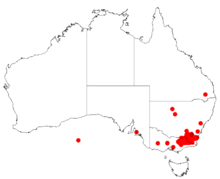Acacia kettlewelliae
Acacia kettlewelliae, commonly known as buffalo wattle, is a tree or shrub of the genus Acacia and the subgenus Phyllodineae that is endemic to south eastern Australia.
| Buffalo wattle | |
|---|---|
| Scientific classification | |
| Kingdom: | Plantae |
| Clade: | Tracheophytes |
| Clade: | Angiosperms |
| Clade: | Eudicots |
| Clade: | Rosids |
| Order: | Fabales |
| Family: | Fabaceae |
| Clade: | Mimosoideae |
| Genus: | Acacia |
| Species: | A. kettlewelliae |
| Binomial name | |
| Acacia kettlewelliae | |
 | |
| Occurrence data from AVH | |
Description
The tree or shrub typically grows to a height of 2 to 10 metres (7 to 33 ft) and has a bushy habit and glabrous branchlets that are angled at the extremities. Like ost species of Acacia it has phyllodes rather than true leaves. The thin, evergreen phyllodes are situated on raised stem-projections and have an oblong to narrowly elliptic to narrowly oblanceolate shape. The phyllodes have a length of around 4 to 10 cm (1.6 to 3.9 in) and a width of 3 to 10 mm (0.12 to 0.39 in) with one nerve per face and obscure lateral nerves.[1] It blooms between September and December[2] and produces racemose inflorescences that are prolific in the upper axils. The spherical flower-heads contain 8 to 11 loosely packed bright light golden flowers. The firmly chartaceous seed pods that form after flowering are glabrous and covered with a fine white powder. The pods have a length of 5 to 10 cm (2.0 to 3.9 in) and a width of 8 to 14 mm (0.31 to 0.55 in) and open unilaterally. The dull black seeds within the pods are arranged longitudinally and have an oblique oblong-elliptic to ovate shape with a length of 4 to 5 mm (0.16 to 0.20 in).[1]
Taxonomy
The species was first formally described by the botanist Joseph Maiden in 1916 as part of the work Notes on Acacia, (with description of new species) as published in the Journal and Proceedings of the Royal Society of New South Wales. It was reclassified as Racosperma kettlewelliae in 2003 by Leslie Pedley then transferred back to genus Acacia in 2006.[3] The specific epithet honours Agnes Louisa Kettlewell, who was an official with the Wattle Day League.[2]
Distribution
It is native to south eastern parts of New South Wales in the Great Dividing Range and north eastern parts of Victoria.[1] Its range is from around Tumut in the north to around Omeo in the south where it is often found on the lower slopes, on granite hillsides, along river flats and in gullies as a part of dry sclerophyll forest and woodland communities.[2]
See also
References
- "Acacia kettlewelliae". World Wide Wattle. Western Australian Herbarium. Retrieved 15 June 2019.
- "Acacia kettlewelliae". PlantNet. Royal Botanic Garden, Sydney. Retrieved 1 September 2019.
- "Acacia kettlewelliae Maiden". Atlas of Living Australia. Global Biodiversity Information Facility. Retrieved 1 September 2019.